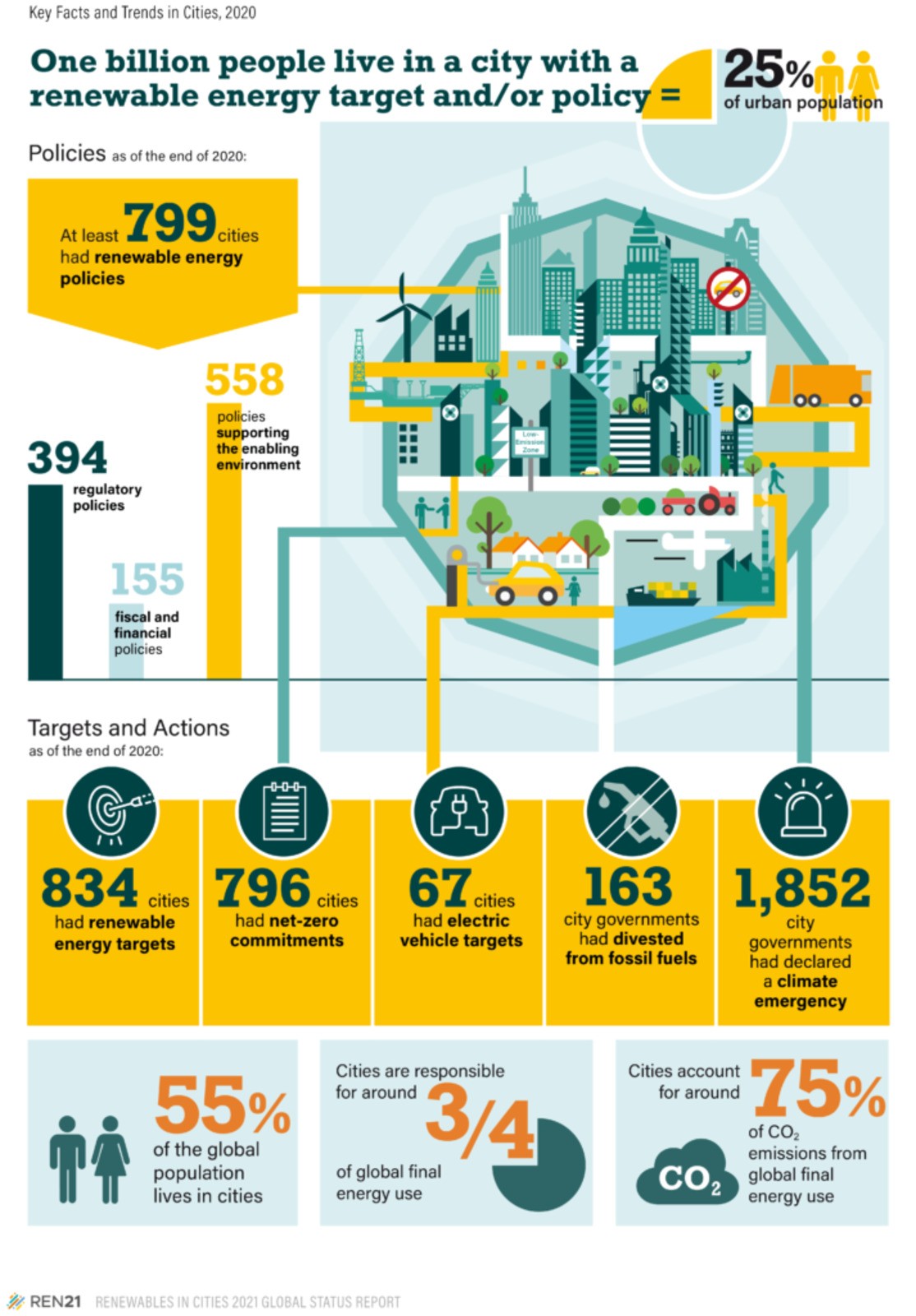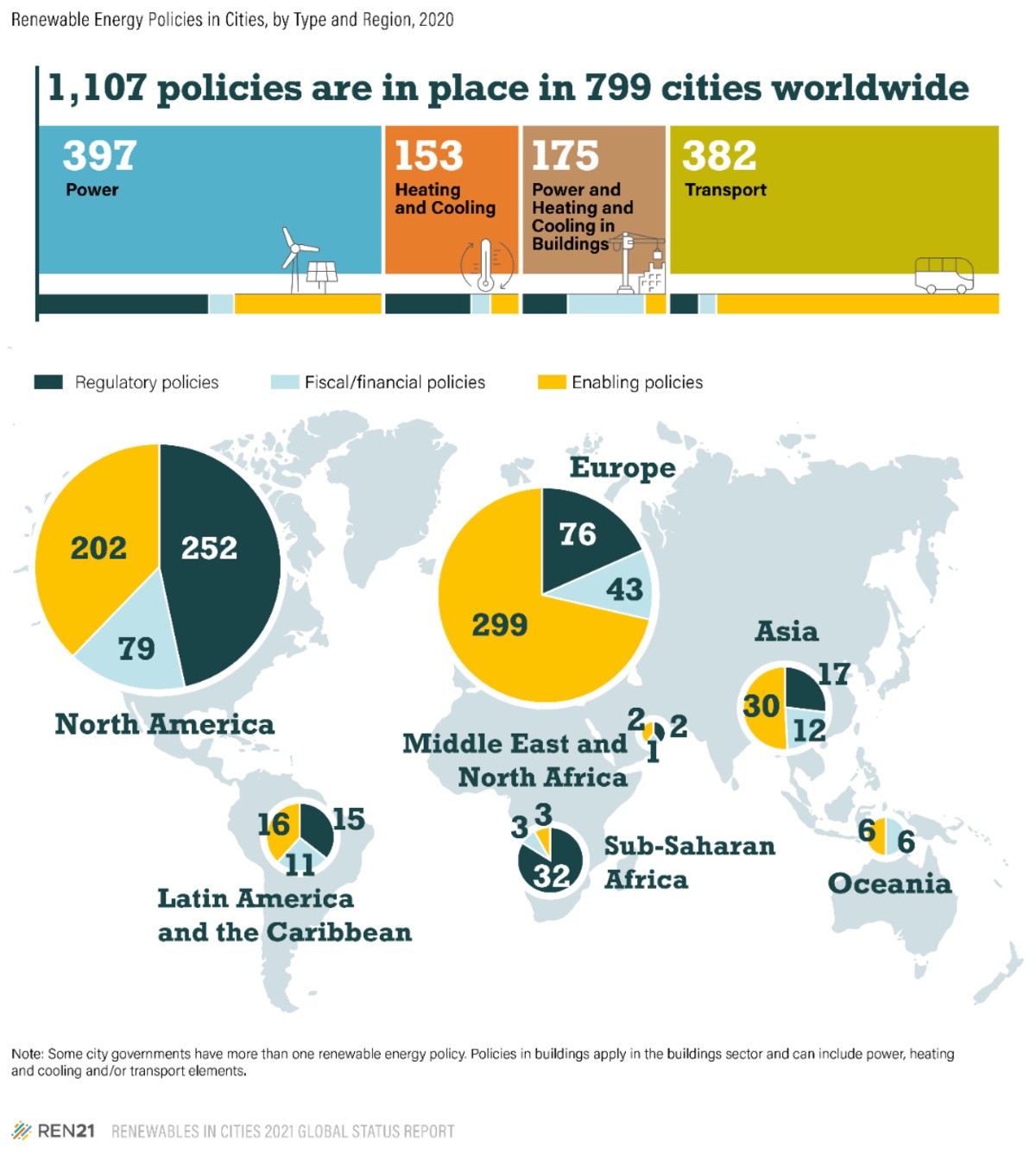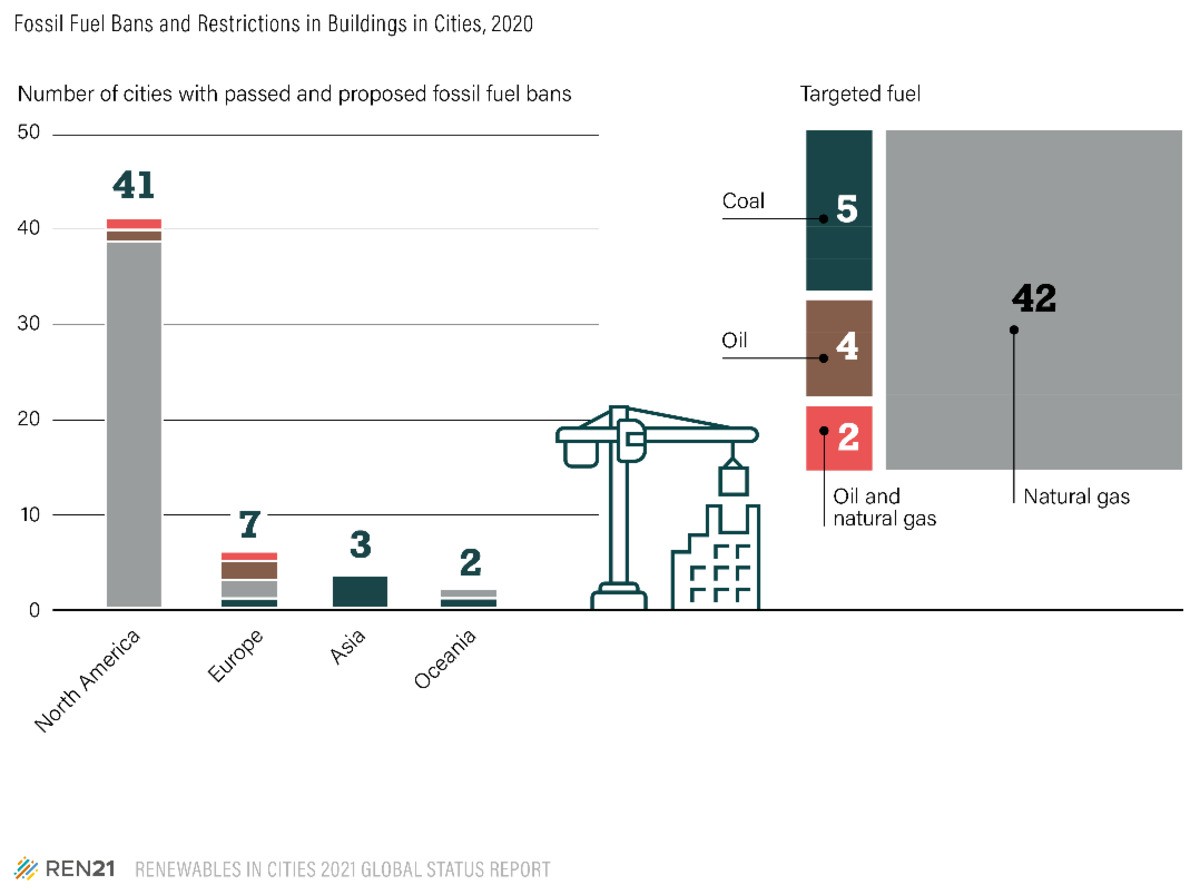Cities can lead the decarbonisation of buildings and be trailblazers for renewables
Katherine Findlay

The Renewables in Cities 2021 Global Status Report shows that more than 1 billion people – about 25% of the urban population – live in a city with a renewable energy target and/or policy. Over 1,300 cities, from the Americas to Sub-Saharan Africa, have demonstrated leadership in advancing renewables beyond the power sector, including decarbonising buildings.
Cities are home to 55% of the global population (and growing) and generate more than 80% of global GDP. Urban energy use has also grown significantly over the past decades. Today, cities are responsible for an estimated three-quarters of global carbon dioxide emissions. This makes cities high-impact areas for climate action, including for decarbonising the energy system and accelerating renewable energy investments, which help cities to achieve their own objectives as well as global goals.
Cities are a high-imact area for climate action
City governments around the world have increasingly recognised the potential of renewables to help fight energy poverty, reduce air pollution, improve public health and well-being, and tackle climate change. Against the backdrop of rising global climate movements, citizens have been exerting pressure on their city (and national) governments to act on climate change. Partly in response to this, by the end of 2020 a record 1,852 municipal governments in 29 countries had declared climate emergencies – up from 1,400 in 2019. Some of these cities have climate action plans that support renewable energy.
Urban commitments to directly support renewables are increasing. In 2020 alone, more than 260 cities either set a new renewable energy target or passed a new policy. As of the end of the year, over 830 cities in 72 countries had adopted renewable energy targets, with more than 600 cities having targets for 100% renewable energy. In some cases, city targets are more ambitious than those set by higher levels of government.
Commitments to transition away from fossil fuels can also result indirectly in greater use of renewable energy city-wide: by 2020, over 10,500 cities had adopted targets to reduce their greenhouse gas emissions and around 800 cities had committed to net-zero emissions, with the number of such net-zero targets increasingly roughly eight-fold from 2019.
In order to achieve these targets and commitments, city governments have been leading by example, scaling up on-site renewable energy generation and/or procurement for public buildings. They have installed, purchased and contracted for renewable energy to meet the demand of municipal buildings, and implemented policies to incentivise local renewable energy generation and consumption city-wide.
Citizens are acting for renewable energy
City governments also have used participatory governance to include citizens in urban planning, budgeting and policy development. For instance, in Amsterdam (Netherlands), citizens were invited to contribute to the city’s heat transition vision for a fossil-free heating system by 2040, which was open to public comment until mid-2020. More and more citizens have also chosen to purchase energy from providers offering renewable electricity or heat, to increase self-consumption of renewables and to create community energy projects in cities. This shows that municipal governments are only responsible for part of what happens in cities; businesses, households, communities and other urban actors also play a role, often encouraged by public policies.

City-level policy portfolios are expanding beyond power to heating and cooling in buildings
The world is not on track to meet the Paris Agreement goals. While renewables have grown in the power sector, the share of renewables in heating and cooling of buildings remains low at around 10%. Action is urgently needed since buildings, concentrated in and around urban areas, account for over 30% of global final energy demand, contributing significantly to local air pollution due to their reliance on fossil fuels.
Although target-setting in cities has focused on the power sector (around 75% of the targets), urban policies and investments have increasingly moved beyond power. Contrary to the slow national-level trends, momentum has been growing for city-level policies and action that support the transition to renewables-based heating and cooling in buildings. By the end of 2020, around 800 municipal governments had in place regulatory policies, fiscal and financial incentives, as well as indirect support policies which enable the uptake of renewables city-wide. Of these, around 150 cities had a total of 175 policies aimed at decarbonising buildings through both renewable power and renewable heating and cooling. In addition, some of the 397 policies aimed exclusively at the electricity sector and some of the 153 policies focused on heating and cooling more broadly also apply to buildings.

Urban policy trends for buildings include the rise of municipal codes and mandates for new buildings that require renewable energy use for electricity or heating (usually solar PV or solar thermal), in addition to focusing on reducing energy demand and promoting nature-based solutions. Renewables for existing buildings are encouraged through financial and fiscal incentives such as grants, rebates and low-interest loans. Momentum is also growing rapidly for bans and restrictions on fossil fuels in buildings: as of 2020, a total of 53 cities spanning 10 countries had proposed or passed bans or restrictions on the use of gas, oil or coal in buildings for space and water heating.
National and state governments must empower and support city leadership, not undermine it
But even those cities that seem ready and willing to move forward run into obstacles. In many cases, state and national-level red tape prevents city governments from taking bolder climate action. For example, by the end of 2020, bans on the use of fossil fuels in buildings were passed or proposed in at least 35 cities within the state of California (United States). Several other cities in the US (and elsewhere) had indicated their intention to adopt similar fossil fuel bans or restrictions. However, as of 2021 at least nine US states have introduced bills to stop cities from banning natural gas hook-ups in buildings. Arizona was the first state in the country to pass such legislation in 2020.[i] Such moves by state governments to pre-empt city-level building electrification mandates place significant hurdles on urban decarbonisation pathways.

Many other challenges remain, such as limited regulatory and financial powers at the city-level, including lack of municipal funds and access to external funds that can support local renewable energy generation projects. Urban energy and climate strategies must be regionally and nationally anchored. This will ensure policy coherence and support between national and sub-national frameworks and action. City governments also need to be empowered to understand their vital role in the energy transition. Globally, we can increase the level of ambition and progress in meeting climate and energy goals if national governments provide cities with the support well beyond creating better financial conditions.
To learn more, read the Renewables in Cities 2021 Global Status Report, REN21’s annual stock-take of the global transition to renewable energy at the city-level. The report maps ways that cities are advancing energy and climate agendas and presents hundreds of examples of best practices. The report is co-authored by over 330 experts and endorsed by an Advisory Committee of 20 organisations, including city networks and renewable energy experts.
[i] N. Groom and R. Valdmanis, “As climate fight intensifies, U.S. states seek to block local natural-gas bans”, Reuters, 5 March 2020, https://www.reuters.com/article/us-usa-climatechange-naturalgas-idUSKBN20S1G8; T. DiChristopher, “Gas Ban Monitor: States launch anti-ban blitz as electrification efforts grow”, S&P Global Market Intelligence, 29 January 2021, https://www.spglobal.com/marketintelligence/en/news-insights/latest-news-headlines/gas-ban-monitor-states-launch-anti-ban-blitz-as-electrification-efforts-grow-62336952.



